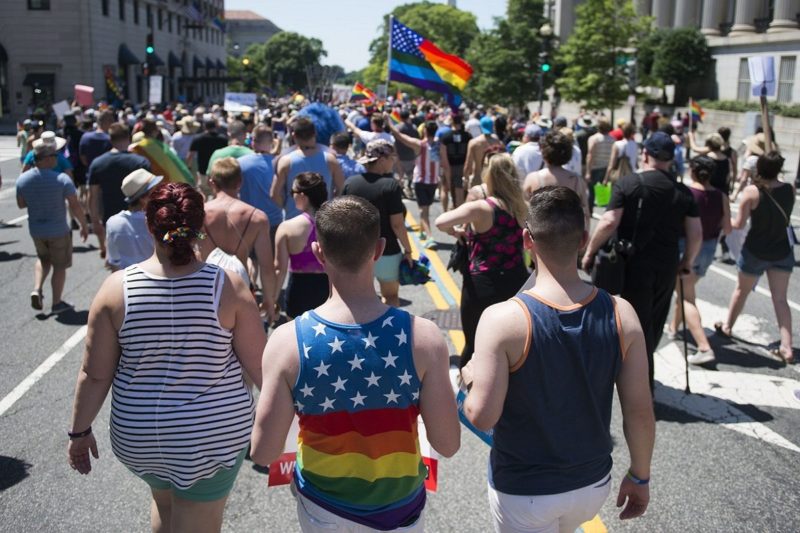This Pride Month, Don’t Overlook Bisexuals
The combination of invisibility and what others see as an illegitimate identity carries significant costs when it comes to resources, which compounds the damage.

At a time when modern science has made great advances in HIV prevention and marriage equality is legal, it’s easy to get caught up in the excitement of the strides LGBTQ people have made in the United States—especially during Pride Month. However, many people still face inequality and oppression based on their sexual orientation, including bisexuals.
Bisexual people frequently experience a dual social pressure to either fit neatly into the gay community or face invisibility. This has real consequences—among them, higher levels of poverty and violence, along with worse health outcomes.
Common myths about bisexuals include assumptions that bisexual men are actually gay and bisexual women straight. And all over the gender spectrum, peers, both gay and straight, deem bisexual people as suspicious and promiscuous.
Another frequently encountered assumption is that bisexuals enjoy privileges from “passing” as straight, a claim against which Lauren Beach, director of LGBTI research at Vanderbilt University Medical Center, balks. She says the dominance of heterosexuality in institutions and culture—heterosexism—is an underlying cause for the false belief that bisexuals are privileged by their ability to “pass as straight.”
As Beach points out, “We know ‘closeting,'” or hiding one’s sexuality because of homophobia, “is bad. But suddenly when [bisexual] people are closeted it becomes privilege?”
The combination of invisibility and what others see as an illegitimate identity carries significant costs when it comes to resources, which compounds the damage.
Brian Dodge, co-director of the Bisexual Research Collaborative on Health at Indiana University, told Rewire, “I think it is important to remember, overall, that the idea that bisexuality is a valid and legitimate sexual orientation/identity is actually challenging for many people, including some social science researchers. Thus, research on bisexuality and bisexual people’s lives has simply not seen the same level of investment and resources as other research on sexual orientation and health.”
Studies on bisexuality, for example, often give an incomplete view, especially when it comes to intersecting oppressions such as gender and race. A 2012 report from Funders for LGBTQ Issues found that less than 1 percent of funding for all LGBTQ organizations goes toward bisexual-specific support programs. Beach attributes the stark absence of resources for bisexual issues to the dominance of the HIV lobby, where most of the funding goes. (Notably, studies on Black and Latino men—who have the highest rates of HIV infection—are also underfunded.) The absence of resources, and thus data, translates into fewer solutions.
Existing research supports the argument, however, that bisexual women experience a poorer quality of life than their lesbian and straight counterparts. A joint report by the Movement Advancement Project, BiNetUSA and the Bisexual Resource Center finds bisexual women more likely to live in poverty—at a rate of 30 percent—compared to straight women, who had comparable rates to lesbians at around 21 percent. These findings accompany a 2010 Centers for Disease Control and Prevention study showing bisexual women are survivors of sexual assault at a rate of 61 percent, compared to 43 percent of lesbians and 35 percent of straight women.
Apart from food insecurity and sexual violence, studies show bisexuals are the most likely of the LGBTQ community to have some cancers due in part to low rates of health insurance. They’re also more likely than lesbian and straight women to experience depression and suicidal ideation.
And while very little research exists that attends to being members of multiple vulnerable communities, such as being a bisexual person of color or transgender person, the studies that do exist suggest race and gender identity are exacerbating factors when it comes to poor quality of life for bisexual people.
Beach says when it comes to poor health, a major cause of bisexual disparities is stigma. She points to minority stress theory as an explanation, which draws correlations between prejudice, discrimination, and a higher likelihood for psychological distress and physical health problems.
Beach underscores, “Marginalized populations experience stigma in different ways. Poor health indicates a population has stigma. With bisexual people, we know we’re stigmatized because we have poor health outcomes.”
Sharif “Herukhuti” Williams, the founder of the Center for Culture, Sexuality and Spirituality, assigns partial blame for this stigma to the gay rights movement itself. He says that the movement has focused visually, socially, and politically on its gay and lesbian members, ignoring bisexuals, who comprise 40 percent of the community. Films like The Normal Heart, United in Anger, and Milk have been important in documenting the struggle for gay civil rights. However, they have largely failed to include people like Brenda Howard, a bisexual woman who organized the first Pride parade in New York, or the prominent Black bisexual feminist poet June Jordan.
Assumptions that bisexual people are in a straight or gay “phase” that will pass play a large role in whether organizations and research can begin to change the climate of disproportionate marginalization facing the bisexual population. This Pride month, the LGBTQ community has the opportunity to effect change within its ranks. By amplifying and celebrating bisexual people along with other frequently overlooked members of our community, Pride parades and marches can be vanguards of social change.
